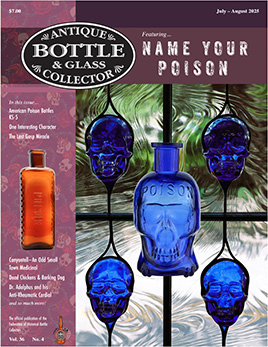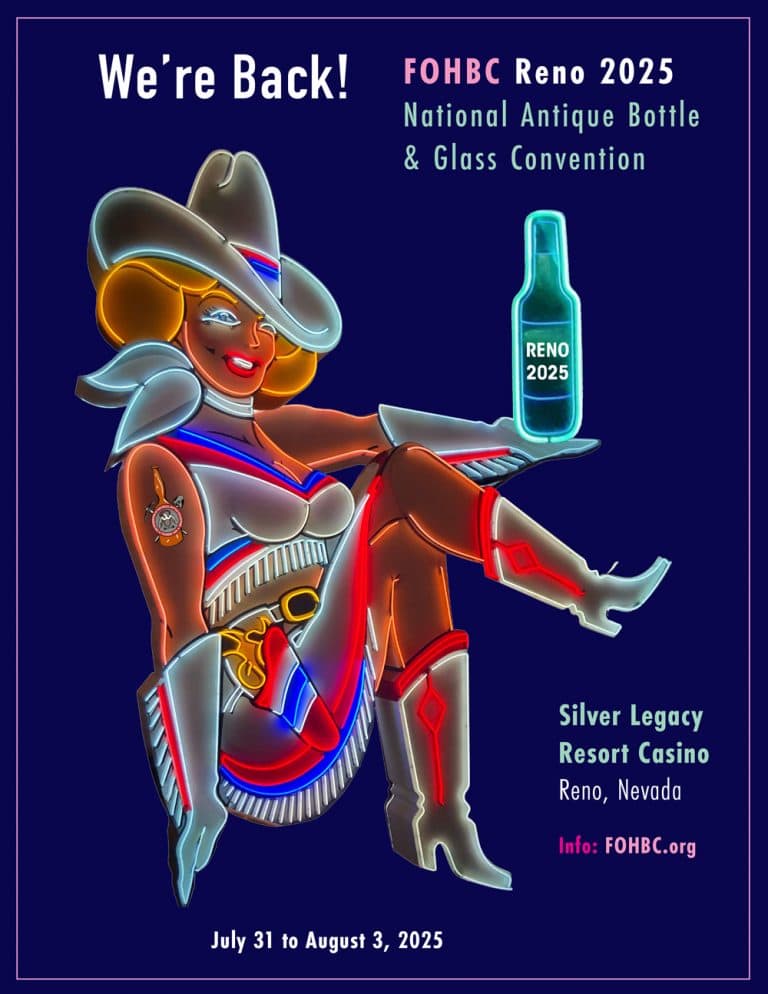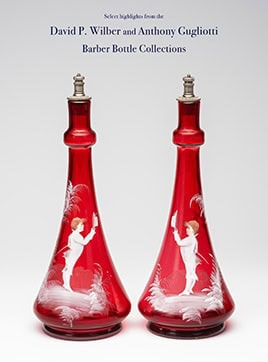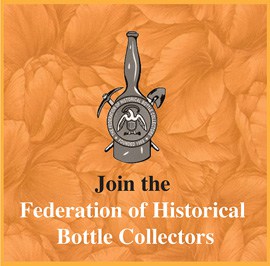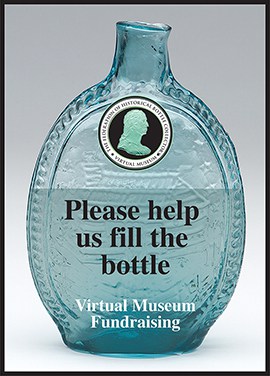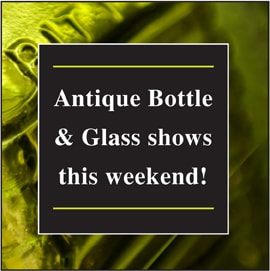March | April 2013 Issue – Legends of the Jar – Wayne and June Lowry
[Editor’s Note: This article is a result of long time collector and author Bruce W. Schank reaching out to long time collectors Wayne & June Lowry.]
Wayne and June Lowry are seemingly in a category all of their own when it comes to collecting fruit jars because they collect fruit jars and related items as a couple. Both of them love fruit jars and both actively seek and add to a collection that represents their combined love and interest for the hobby. June told me that when Wayne became interested in fruit jars she figured she would too because she wasn’t going to sit home alone while he ran around looking for them and the rest is history. I had to think long and hard about it but I really don’t know of any other “collector couples” that exist. The fruit jar hobby is basically a guy thing with the spouses being either the I don’t want to know a thing about them type and it’s a waste of time, money and energy, the accepting but disinterested partners or the enthusiastic cheer leader partners even liking or enjoying the jars outright but themselves not active collectors.
Wayne & June started out in this wonderful hobby of ours by finding a Cross Mason’s CFJCo clear quart. At the time Wayne was collecting coins and the date on the jar was older than any coin he currently owned and that rather impressed him. So he bought a total of four jars including a Hero cross, Keystone and another common monogrammed 1858. Now that all occurred in 1977 and they paid a whopping $4.57 a piece for those jars. Then they bought the book on fruit jars by Julian Harrison Toulouse and discovered that the clear cross Mason’s CFJCo quart was worth approx., $50 which was a lot of money in late 1978 early 1979. Well suffice it to say, that was the impetus that caused them to endlessly go out to garage sales and flea markets looking for fruit jars. They both enjoyed finding jars listed in the book for $10 selling for only $2 so they would buy any and all they could find.
In the very beginning they collected any and every kind of jar imaginable and in every size so it wasn’t very long before the collection mushroomed into somewhere between 4,000 and 5,000 jars. And like most reasonable thinking people they quickly realized that too many jars was basically unmanageable and besides there was no way they were going to be able to collect every kind of fruit jar let alone each and every size the jar came in. They were really attracted to pints so that’s what they focused on including pint boxes and lid boxes. So they slowly sold off all of the other sizes and many sets until they had nothing left but pints. Their collection at one point was considered by many in the hobby probably The Best “Pint” Fruit Jar collection in the country.
Flaccus pints happen to be another big focal point for June and that interest also came about from the Toulouse book because of the amber pint on the front cover. June’s parents interestingly enough happened to raise steer in South Missouri so it was just a natural thing for June to want jars that had steer heads on them. Wayne tended towards the Hirsch Bros jars and after many years they both assembled a very nice lineup of those wonderful jars. One of Wayne’s other main interests was the varying different kinds of jars in pint size. Color was not a priority because color was rather expensive even in the early years of the hobby. So Wayne looked instead for odd closured jars and weird unlisted and different uncommon pint jars that didn’t cost a lot but were very scarce or rare compared to other jars. Midgets as well seemed to find a resting place on their many shelves and for both of them a favorite item.
Wayne and June also have a huge passion for many different things other than fruit jars and actively collect beaters, stoneware, little red riding hood items, toys, bottles, Aladdin lamps and so many other things too numerous to mention here. Their house is chock full of tons of wonderful antiques and collectables and it’s fascinating to walk around and look over and examine all of the varying different items in their extra humongous home.
On a fateful day in 1983, Gerry Phifer had a yard sale and one in which Wayne and June happened to go to. Strangely enough, Wayne and June lived in Topeka KS at that time and not only did they not know who Gerry was but never knew he only lived 3 or 4 miles away from them. Gerry of course had fruit jars for sale there and it was at that yard sale they not only met Gerry but found out about the local bottle club and discovered that there was such a thing as a bottle show. The very first Bottle Show Wayne and June attended was the 1984 Indy Show and since then they have attended many numerous shows across the country all of these years finding pint treasures wherever they went. As a matter of fact, they told me how they brought $800 with them (which was a large amount of money then) to that 1984 Indy Show and had it spent within an hour. They continued spending though because they saw jars there they had only seen in books and dreamed about. When it was all over and the dust had settled they had gone just hog wild and ended up taking out a loan in order to pay for all of the stuff they had bought.
Wayne and June since early on have been serious players in the hobby and actively involved in the Federation of Historical Bottle Collectors in various positions as well as many local and not so local bottle clubs. I can still remember the very nice ABC pint display they put together at the January 1989 Indy Show and it was again no different at the York 2008 Expo when they had yet another fabulous display of 47+ rare pint jars. As a couple, they have been actively involved in the hobby helping it to grow as well as promoting the fruit jar hobby in general through lots of hard work, time and effort sponsoring many hobby related endeavors. They claim had they not walked into that antique mall that fateful day in 1977 their life would have been so much different today. They have so many friends and acquaintances around the world simply because of the fruit jar hobby.
Another very big part of both June and Wayne’s life has been his business, “Jar Doctor.” He started out in 1990 with a photographed copy of a photographed copy of how to use copper, water and oxide (article actually described tin oxide) to polish glass. Phil Robinson had the copy Wayne made a copy of and it originated from a guy in California by the name of Pat Mc Koda. They now own an original pamphlet he had produced. In the pamphlet he had a little illustration of a gizmo that hand turned bottles with a solution that allowed you to polish the inside of a bottle. Wayne says it wasn’t much of anything and kind of impractical to say the least. He spent the major part of two years brainstorming and developing a tubular system where you could clean the inside, outside and bottom of a bottle all at once. Wayne believes he was the first person to have ever done that and obviously that was a major accomplishment to say the least.
Soon after he had people asking him if he could build them a machine when they found out he was doing the inside, outside and bottom all at once and with that he had his very first order in 1992. He figured he would build maybe a half a dozen machines and it would all be over but it just kept going and going and going and to this day Wayne is building bottle cleaning systems incorporating all of the changes and advancements he has come up with over the years. He’s now into his fourth generation machine with each generation having an average of two or three versions a piece so he’s probably into his twelve version of the original machine.
Wayne told me at the time, bottle and jar cleaning was being done by a small handful of people and it was a very secretive process. No one was willing to share with anyone else what they were doing or how they were doing it. He says people were building many different types of contraptions and in the process breaking and destroying many items. He felt once he had perfected his method that his main goal was to share it with the rest of the collecting world. Wayne says he shares any and all information since then and he will never keep anything a secret. If he learns something new or someone calls him to say they figured something else out he shares it with everyone period.
Folks, I don’t know if you realize this but Wayne IMHO single handedly changed the entire glass hobby in the greatest possible way when he developed his cleaning process and machine. Just think about this; how many jars and bottles mind you would be basically worthless without the cleaning machine process Wayne ingeniously came up with? Jars and bottles that were worth only a small fraction of their true value instantly became stellar valuable items and treasured possessions to a whole multitude of collectors who otherwise would have relegated them to back shelves or boxes due to sick glass and other related issues. Once again IMHO the bottle collecting world owes a debt of gratitude for what he has done and how he transformed collecting bottles, jars and glass by his wonderful and ingenious cleaning machine process.
I had quite a nice visit with both Wayne and June who were very nice hosts. I found out too that Missouri is a very beautiful State indeed. The Lowry’s live in a humongous home on a wonderful little lake in a sleepy, cozy area in the North West section of the State. If I had any regrets while there it was only that I didn’t get to see their fabulous and once famous 350+ half pint jar collection as well as the wonderful midgets that they had once owned. Sadly, they sold them all 10 years prior to me even thinking about doing a story about them or anyone else for that matter. What a shame but as I travel across this great land of ours I seem to come across many of those little treasures residing in other peoples collections now so it isn’t so bad after all.
June is a former FOHBC Business Mgr and (Acting) Editor of Bottles & Extras magazine while Wayne is a former FOHBC Convention Director. I am extremely grateful to June that she gave me a chance that ultimately led to a solid platform for my Stories when she agreed to insert a 2008 York Expo Trip Report I wrote in the Nov/Dec 2008 issue. The Legend series of articles have appeared on a regular basis since the March/April 2009 issue. And hopefully until this humble author no longer has a story to tell or I am unable to tell a story…
March | April 2013 Issue – Arthur McGinnis and the Great Whiskey Heist – Jack Sullivan
ARTHUR MCGINNIS AND THE GREAT WHISKEY HEIST
By Jack Sullivan
Special to BOTTLES & EXTRAS
In early January1926, as many as 50 men entered the government-held liquor warehouse of the McGinnis Distillery near Baltimore and hauled away 71 barrels and 32 cases of aged rye whiskey, with a present day value of more than a million dollars. It was the kind of bold caper that Arthur McGinnis, founder of the distillery and 21years dead, might well have admired.
Arthur himself was a bold man. An immigrant from Ireland he began his American career during the 1870s as a wagoner, like the one shown here (Fig. 1), working out of the east side of Baltimore. It was a difficult life, usually requiring hard work and heavy lifting. McGinnis knew he was meant for better things. His intelligence and “go getter” attitude brought him to the attention John B. Brown, the owner of a successful liquor outfit Brown had founded in 1869. The company flagship brand was Brown’s Malt Whiskey that the owner merchandised as a medicinal beverage. An 1891 ad asserted: “Brown’s Malt Whiskey is a cure for Indigestion, Brown’s Malt Whiskey is a Tonic and Invigorant, Brown’s Malt Whiskey is a Healthful Beverage, Brown’s Malt Whiskey is a Genuine Distillation, Brown’s Malt Whiskey is used by all Classes” (Fig. 2).
Brown hired McGinnis in the mid-1880’s and taught him the liquor business. One of Brown’s sons, J. Badger Brown, was involved with the company but appears to have died early. In 1895 the name of the firm became Brown, McGinnis & Company. McGinnis’s three sons — John, James and Patrick — all became involved in the business. This firm appears to have bottled and sold wine as well as whiskey. By 1905, Brown’s name had disappeared entirely and the A. McGinnis Company of Baltimore emerged.
The Distillery at McGinnis Siding
McGinnis reorganized the firm, incorporated it and personally invested an additional $5,000. Other incorporators and investors included sons John and James along with two of Arthur’s Irish compatriots, Martin O’Connor and Patrick McGrath. With the infusion of new money McGinnis built a distillery adjacent to the Western Maryland Railroad at a place that came to be called McGinnis Siding. It was located four miles from Westminster, Maryland, but Arthur chose to name the site “Carrollton.” This identified the location with John Carroll, the state’s signer of the Declaration of Independence. The place existed only in Arthur’s rich Irish imagination. McGinnis Company offices remained in Baltimore, first at 208 Lexington Av. and then in the American Building downtown (Fig. 3).
Almost from the beginning, the whiskey business was successful and McGinnis Rye enjoyed strong regional sales. In 1905, the State Tax Commissioner set the taxable value of distilled spirits for the McGinnis Co. at $13,368. By 1907 that figure had grown to $21,496, and by 1909 had jumped to $62,760. Even with this growth the McGinnis distillery was among Maryland’s smaller operations, able to process only a relatively modest 250 barrels of mash per day.
The whiskey was bottled in a range of readily identified containers. McGinnis labeled square quarts bottles could be found in both clear (Fig. 4) and amber (Fig. 5). All were embossed with the name of the distillery (Fig. 6). McGinnis Pure Rye also came in a pint flask (Fig. 7) and an embossed miniature bottle (Fig. 8). The firm issued merchandising giveaway items to saloons and selected customers including back of the bar bottles and shot glasses (Figs. 9-11)
.
Arthur’s Recklessness Is Revealed
In November 1905, Arthur was injured in an accident and after lingering for a few weeks, died. His death triggered not only tumult at the A.McGinnis Co. but a legal dispute that fractured his family. The attempt to settle his estate required investigation of the balance sheets of the distillery. Except there weren’t any. As his son James told the court, Arthur “carried a bank book and a little stub. He carrried the bank book in his pocket and the cashbook in his head. That is how he ran the business.”
As the court determination subsequently stated, McGinnis’s company had been a success but, “the financial part of the concern was managed in a most loose and careless fashion.” Arthur’s recklessness engendered legal actions that pitted Mary McGinnis (likely his widow) and son James against son John and other investors. After the case reached the Maryland Supreme court a settlement was made among the McGinnises.
What happened then is not entirely clear even to their descendants. Apparently James and John mended their differences. Brother Patrick entered the picture as a whiskey executive. A Baltimore company called McGinnis Brothers was created in 1905 and existed along side the A. McGinnis & Company until Prohibition shut both of them down in 1920. At the time the McGinnis distillery was still operating and its warehouses were full of aging whiskey. The facility was put under U.S. Government control and the product was slated to be extracted in small amounts and sold for allowable “medicinal purposes.”
The lure of so much whiskey in one place proved very tempting to bootleggers. In 1922, the head of a Baltimore ring named Charles Scandalis was caught trying to secure liquor from the McGinnis Distilery using false permits. Convicted, Scandalis later converted to being a Prohibition enforcement officer and was murdered on the job. The site drew other violence. The Baltimore Sun of March 30, 1923, recounted that a second attempt had been made in two weeks to rob the McGinnis warehouse of its whiskey. The would-be robbers shot at the guard on duty who used a shotgun to wound several of the miscreants and put them to flight. They were never caught.
The Great Whiskey Heist
These incidents all were a prelude to the events of January 8, 1926. On that fateful winter afternoon, according to witnesses, three men, earlier seen ice skating on a nearby pond, suddenly confronted a government guard named Charlie Thompson. They drew pistols and tied him up. The next to be trundled was an 80-year-old man who had wandered by the scene looking for his lost cat. In time some seven guards and watchmen were shackled and a gang, estimated at from 40 to 50 men, made themselves at home in the distillery for a full15 hours.
The robbers not only were professionals, they knew something about whiskey. Sampling on each floor as they went, a time consuming process, they passed up the newer barrels on lower levels of the warehouse to get the well seasoned booze on the seven and eighth floors. Taking all night, by dawn they had loaded five trucks with 71 barrels of the oldest whiskey and 32 cases of bottled stock. The total value of the liquor at the time was estimated at $100,000 — more than a million dollars today. Federal officials later traced the trucks, now accompanied by mobsters in automobiles, south to Mexico. Crossing the border, the trucks may well have been disguised as this clever bootlegger “lumber” wagon (Fig. 11).
A subsequent hearing into the robbery by a Federal grand jury in March 1926 deteriorated into a finger-pointing exercise. The stolen whiskey and the men responsible for the robbery seemingly had evaporated into thin air. Suspecting an inside job, the guards and nearby residents had been grilled relentlessly by the U.S. District Attorney but to no avail. The head of the Maryland Anti-Saloon League launched a bitter attack on Federal officials blaming “too much temporizing and too much politics” for the looting.
In April of that year, a Baltimore man named James Geisey of Baltimore and six accomplices were charged with the crime after being caught transporting carloads of beer into Baltimore via railroad. The record does not reveal if they ultimately were tried or found guilty. Nevertheless, taking no more chances, Federal officials moved the remaining whiskey to another location and in October 1926, brick by brick, tore down the distillery that Arthur McGinnis had built and sent the building materials to New York.
*******
Illustrations:
Fig. 1: Photo of an Irish wagoner
Fig. 2: J.B. Brown ad, 1891
Fig. 3: American Building, Baltimore
Fig. 4. Clear McGinnis Quart
Fig. 5: Amber McGinnis Quart
Fig. 6: Amber McGinnis flask
Fig. 7: McGinnis embossing on four bottles
Fig. 8: McGinnis clear miniature
Fig 9: McGinnis back of the bar bottle
Fig. 10: McGinnis shot glass #1
Fig. 11: McGinnis shot glass #2
Fig. 12: A bootlegger’s truck

